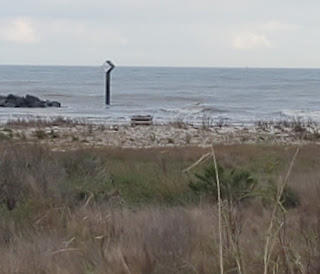Thursday February 4
Notes from the time:
Last day at this place. I like it, a lot, but I'm ready to leave. Two months from now this place will be awash with warblers, but right now it's awash with a single species: yellow-rumped warblers (I call 'em butterbutts). Also mockingbird, a few phoebe, and a handful of House Sparrows which I haven't seen since Paducah. House sparrows are an import from England, and they flock in cities and nest in eaves. Making a huge mess.
Every gull which I've identified has been a pied-billed gull, same as we have back home. Oh, no-that's a mistake. I did see a herring gull or two, and a laughing gull. Out on the beach. There are no gulls around the campground, just an occasional flyover. Which is odd.
There are rabbits in the bushes, but I haven't seen the foxes or bobcats that should be eating them. I may have seen bobcat poop on the trail. Speaking of poop--Molly has given herself runny bowels from all the crap she's been eating off the ground. Serves her right--but I'm the one who has to deal with it. 
After breakfast Ed and I went out to the beach with the goal of walking east to the big tower and its long walkway to the fishing pier, set way high up over the surf. It would be interesting to know how shallow the water is down there, but I'm not walking out there to find out for sure--cold, and dangerous. I'd guess not more that six feet deep. Ocean shore depth is tricky because it varies so much depending on where the wave is at--one minute you're down to your ankles, next minute up to your chest. Or worse.
We made it to the walkway. We could see that the groups of rocks protecting the shore come to and end down there when the shore bends around to the north. The beach is closed--posted against trespassers--just past the fishing pier. Protected habitat for shore birds. I approved, greatly, but I did so want to keep walking!
There were lots of dolphins out in the water, along with all the usual water birds. From the walkway we could see White Pelicans mixed in with the crew. We have plenty of White Pelicans back home, wintering on the Texas lakes, but it's unusual to see them on the ocean. While we watched, from time to time a huge crew of waterbirds would fly up and mill around in masses, then settle back down on the beach. What was stirring them? I didn't see any harriers or other hawks out there. Just doing the seabird shimmies, I guess.
After we returned I took Molly for a jog around the nature trail, although I won't pretend I jogged more than a third of it. Even at my best I find it hard to jog on chunks of gravel, and those chunks were huge and tippy. After you pass the front gate the trail becomes sandy dirt with lots of vines along the ground that grab your ankles and try to trip you up. We got our exercise, but I wouldn't call it jogging by any account.
After that there was only time for a quick lunch and then Ed and I wanted to take showers so he could unhook the utilities, go dump our tanks, and re-hook it with the car loaded on the tow dolly. So we can get a quick start tomorrow, hurray!
If times had been normal and we'd have been able to go explore the little shops in Grand Isle, or if we'd had the Jeep and been able to go to the nearby beach that is famous for good shelling AND for allowing dogs, I'd not have been in such a hurry to leave. But basically, we'd been here and done this. It was fun, but not enough fun to want to stay there indefinitely.
The one thing I wanted to do is go walk on the beach one last time, but I took Molly with me so we were limited to staying on the boardwalk. We could see the water well, and the storm clouds coming in from the cold front which was sweeping through:
And we could hear the waves. Lovely sound. When we first arrived at the park, the wind was blowing from the north and we couldn't hear the ocean at the campsite at all. But on the third and fourth days, the wind calmed down. The ocean was near!
Grand Isle Bird Summary
Sanderlings, Laughing Gull, Pied-billed Gull, probable Herring Gull. Brown Pelican. Tricolored Heron, probably Little Blue Heron, probable Snowy Egret. Osprey. Ibis, dark-colored, species unknown.
Cormorant sp.. White Pelicans and one Brown Pelican (center front):
Black Skimmer in front; Royal Tern in back:
Royal Terns, with one Black Skimmer at the far left front:
Yellow-rumped Warbler, Mockingbird, English (House) Sparrow, Cardinal, Starling, Red-Winged Blackbird. Very likely Common Loon.







No comments:
Post a Comment